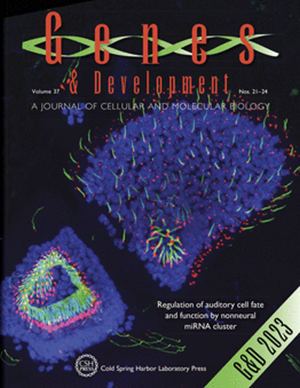Histone chaperones coupled to DNA replication and transcription control divergent chromatin elements to maintain cell fate
IF 7.7
1区 生物学
Q1 CELL BIOLOGY
引用次数: 0
Abstract
The manipulation of DNA replication and transcription can be harnessed to control cell fate. Central to the regulation of these DNA-templated processes are histone chaperones, which in turn are emerging as cell fate regulators. Histone chaperones are a group of proteins with diverse functions that are primarily involved in escorting histones to assemble nucleosomes and maintain the chromatin landscape. Whether distinct histone chaperone pathways control cell fate and whether they function using related mechanisms remain unclear. To address this, we performed a screen to assess the requirement of diverse histone chaperones in the self-renewal of hematopoietic stem and progenitor cells. Remarkably, all candidates were required to maintain cell fate to differing extents, with no clear correlation with their specific histone partners or DNA-templated process. Among all the histone chaperones, the loss of the transcription-coupled histone chaperone SPT6 most strongly promoted differentiation, even more than the major replication-coupled chromatin assembly factor complex CAF-1. To directly compare how DNA replication- and transcription-coupled histone chaperones maintain stem cell self-renewal, we generated an isogenic dual-inducible system to perturb each pathway individually. We found that SPT6 and CAF-1 perturbations required cell division to induce differentiation but had distinct effects on cell cycle progression, chromatin accessibility, and lineage choice. CAF-1 depletion led to S-phase accumulation, increased heterochromatic accessibility (particularly at H3K27me3 sites), and aberrant multilineage gene expression. In contrast, SPT6 loss triggered cell cycle arrest, altered accessibility at promoter elements, and drove lineage-specific differentiation, which is in part influenced by AP-1 transcription factors. Thus, CAF-1 and SPT6 histone chaperones maintain cell fate through distinct mechanisms, highlighting how different chromatin assembly pathways can be leveraged to alter cell fate.组蛋白伴侣偶联DNA复制和转录控制不同的染色质元件维持细胞命运
DNA复制和转录的操纵可以用来控制细胞的命运。对这些dna模板化过程进行调控的核心是组蛋白伴侣蛋白,它们反过来又作为细胞命运调节剂出现。组蛋白伴侣蛋白是一组具有多种功能的蛋白质,主要参与护送组蛋白组装核小体和维持染色质景观。不同的组蛋白伴侣通路是否控制细胞命运以及它们是否通过相关机制起作用尚不清楚。为了解决这个问题,我们进行了一项筛选,以评估造血干细胞和祖细胞自我更新对不同组蛋白伴侣的需求。值得注意的是,所有候选细胞都需要在不同程度上维持细胞命运,与它们特定的组蛋白伴侣或dna模板化过程没有明确的相关性。在所有组蛋白伴侣中,转录偶联组蛋白伴侣SPT6的缺失对分化的促进作用最为强烈,甚至超过了主要的复制偶联染色质组装因子复合体caf1。为了直接比较DNA复制和转录偶联组蛋白伴侣如何维持干细胞自我更新,我们创建了一个等基因双诱导系统,分别干扰每个途径。我们发现SPT6和caf1的扰动需要细胞分裂来诱导分化,但对细胞周期进程、染色质可及性和谱系选择有不同的影响。caf1缺失导致s期积累,异色可及性增加(特别是在H3K27me3位点),以及异常的多系基因表达。相反,SPT6缺失引发细胞周期阻滞,改变启动子元件的可及性,并驱动谱系特异性分化,这在一定程度上受AP-1转录因子的影响。因此,caf1和SPT6组蛋白伴侣通过不同的机制维持细胞命运,强调了如何利用不同的染色质组装途径来改变细胞命运。
本文章由计算机程序翻译,如有差异,请以英文原文为准。
求助全文
约1分钟内获得全文
求助全文
来源期刊

Genes & development
生物-发育生物学
CiteScore
17.50
自引率
1.90%
发文量
71
审稿时长
3-6 weeks
期刊介绍:
Genes & Development is a research journal published in association with The Genetics Society. It publishes high-quality research papers in the areas of molecular biology, molecular genetics, and related fields. The journal features various research formats including Research papers, short Research Communications, and Resource/Methodology papers.
Genes & Development has gained recognition and is considered as one of the Top Five Research Journals in the field of Molecular Biology and Genetics. It has an impressive Impact Factor of 12.89. The journal is ranked #2 among Developmental Biology research journals, #5 in Genetics and Heredity, and is among the Top 20 in Cell Biology (according to ISI Journal Citation Reports®, 2021).
 求助内容:
求助内容: 应助结果提醒方式:
应助结果提醒方式:


